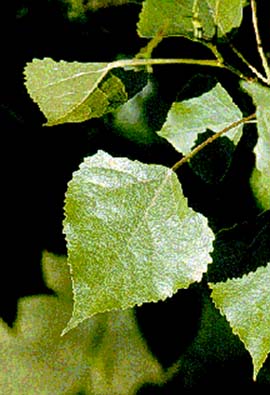Populus fremontii

Common: Fremont cottonwood, Western cottonwood
Family: Salicaceae
Origin: Historically occurred nearly everywhere in Arizona south of Mogollon Rim. Wetlands from California to Texas and from Colorado to Mexico are home to this tree.
Sunset Zone: 7-24
Light: Full sun
Soil: Performs well in any soil type with drainage.
Water: In desert, weekly water is needed during hot weather if roots haven't tapped underground source. For early desert travelers, the presence of the Fremont cottonwood indicated a reliable source of water within digging depth.
This is the cottonwood of desert waterholes and watercourses. Stout, spreading and pendulous branches form a broad, open crown. Fast growing, deciduous. Attain a height of 40-60 feet and width of 20-25 feet.
Yellow-green, triangular leaves, 2 to 4 inches. Leaves make a characteristic fluttering noise when in a breeze. Bark of young trees is light gray, thin and smooth. As the tree ages, the bark darkens, thickens, and breaks into furrowed ridges.
Male and female flowers appear as catkins on separate trees. Male flowers are 1-3 inches long. Female trees product fluffy white seeds in spring, giving the cottonwood its common name. One female tree can easily carpet 500 square feet in billowy "cotton."
This species was named for the famous nineteenth century politician, soldier, explorer, and territorial governor of Arizona, John C. Fremont. Tree has nasty reputation for making a mess, and is illegal to grow in certain communities. Fremont cottonwood is used by Pueblo artisans for large drums, as can be seen in this example from Cochiti Pueblo, made in the early 1900's.